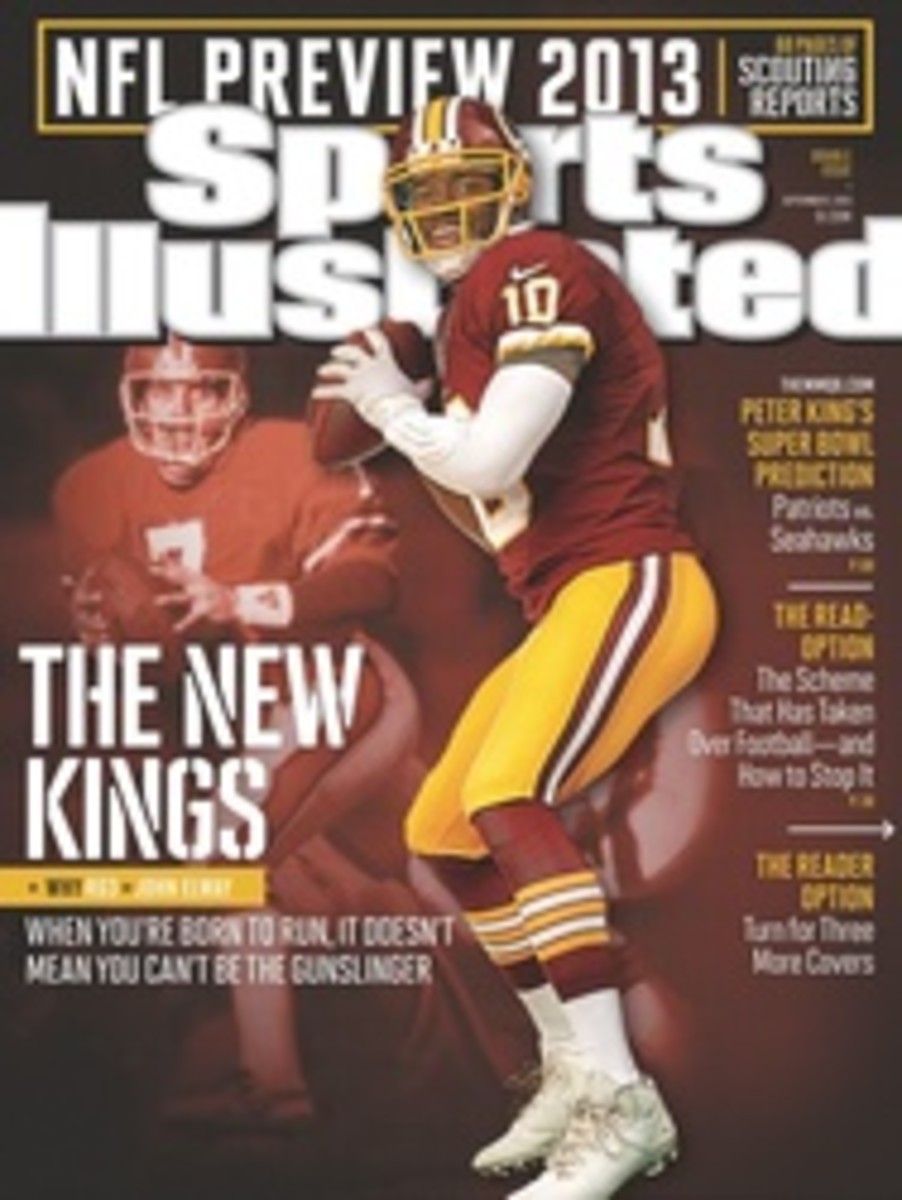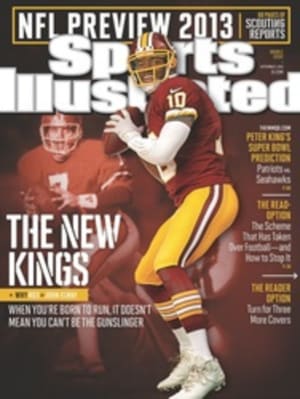
10 Pittsburgh STEELERS
FOR A running back who made jumping over opponents his YouTube signature at Michigan State, there really wasn't much for Le'Veon Bell to hurdle when he arrived in Pittsburgh this spring. The Steelers' running game, a consistent strength not long ago, has atrophied, which explains why the second-round pick found no entrenched starter in his path.
Jonathan Dwyer's meager 623 rushing yards led the Steelers' ground attack in 2012, the lowest total for Pittsburgh's top back since 1991, when Merril Hoge had 610. Four other backs received at least 25 carries last year, but injuries and ineffectiveness resulted in the running game tumbling all the way to 26th in the NFL. As a team the 8--8 Steelers rushed for 1,537 yards, their fewest since 2003.
Those stats drew to an end the Rashard Mendenhall era and the identification, early in the scouting process, of an antidote to last year's committee: Bell, the 6' 1", 244-pound Spartan who slashed, jumped and plowed his way to 1,793 yards and 12 TDs on a hearty 382 totes as a junior last year.
"We're not going to win enough games running the way we did last year," says second-year offensive coordinator Todd Haley. "Everything had to be perfect to make three or four yards. No fault to any one person, but it had to get better."
Bell was the front-runner for the starting job from the beginning of camp (Dwyer, Isaac Redman, LaRod Stephens-Howling and Felix Jones remain relief options), and that didn't change when Bell went down last week with a mid-foot sprain. He's expected to return—as the starter—in mid-September, at which point he'll need to get up to speed quickly. Ben Roethlisberger remains a top 10 QB, but his options are far less enticing with the departure of Mike Wallace. Expect to see shorter drops and more precision routes when Pittsburgh throws. Expect, too, to see more running behind a young, strong offensive line that is built to bulldoze.
"Pittsburgh's a downhill team that likes to run," says Bell. "It fits my style to a tee. With Ben [Roethlisberger] making plays in the passing game, he just needs somebody to make a few running. I want to prove [the team] made the right choice."
It sure seemed like the right choice in camp, where Bell earned the respect of new teammates by holding his own in the "backs-on-backers" drill, in which a running back stands stationary in the pocket and tries to pick up a blitzing linebacker. Coach Mike Tomlin didn't take it easy on the rookie in his first taste of the drill, repeatedly sending pass rushers like veteran LaMarr Woodley his way.
"You want to see how they respond to failure," Tomlin says of the exercise. "How they fight and how they come back is a window [into] what they're going to be."
What are the Steelers hoping Bell will be? That rare rookie who can handle being a three-down back, leaving no confusion about the new backfield pecking order. So far Bell—described by my colleague Peter King as the second-best rookie he saw in camp, behind the Browns' linebacker Barkevious Mingo—has shown good hands and a willingness to improve his blitz pick-up, sorting out traffic in the pocket and identifying where a block must be thrown. But it's his knack for falling forward that is most appealing.
"In this league, there aren't many open areas," says Steelers G.M. Kevin Colbert, "but [Bell] can turn a one-yard hole into a five-yard run. He did that consistently in college in an NFL-style offense. If you do that in the NFL, you're going to have a good career."
Pittsburgh's line is young and struggles with pass protection, but it can mash—especially left tackle Mike Adams, center Maurkice Pouncey and right guard David DeCastro—and it's well-suited to a renewed emphasis on running. The Steelers last season had just eight runs of at least 20 yards, and eight rushing touchdowns; but Bell's blend of vision and explosiveness has Pouncey, the team's best lineman and one of the game's top centers, excited about the prospect of more.
"Some people come in and really can't handle the pressure, but he seems like one of those rookies who can," says Pouncey. "I can't wait to see it [in the regular season]. We're all pumped up about what he can bring."
And Bell bringing it is just the thing the Steelers need to return to the postseason discussion.
THE CASE FOR ...
Outside linebacker Jarvis Jones
From Jack Ham to James Harrison, the glamour position in Pittsburgh's D has been the outside rush-linebacker slot, and Jones is another beast-in-the-making. It's just a matter of time before the first-round pick out of Georgia beats out veteran Jason Worilds and assumes Harrison's old spot. The highest-drafted OLB in team history (No. 17), Jones is a ready-made NFL prospect: He played a 3--4 rush LB role as a Bulldog, so he won't have to make the slow transition endured by former Steelers OLBs, who've traditionally come in as undersized 4--3 college ends and converted to the stand-up spot in the pros. "We're asking him to do a job we saw him do in college," says coach Mike Tomlin. "[It's] an advantage, having played on two feet as opposed to with his hand in the dirt." Jones has the athleticism and nose for the football typical of Steelers OLBs, and in camp he showed a penchant for the disruptive play-making on which Harrison made his name. He looks to be just what Pittsburgh's pass rush lacked in 2012, when it finished with only 37 sacks (15th in the NFL). "Linebackers always lead this defense," says Jones. "I want to take on that challenge." It will be his soon enough.
SINCE YOU'VE BEEN GONE
(R) Rookie— College stats
PHOTO
HARRY E. WALKER/MCT/ZUMAPRESS.COM
RB LE'VEON BELL
PHOTO
JAY TALBOTT/ICON SMI

